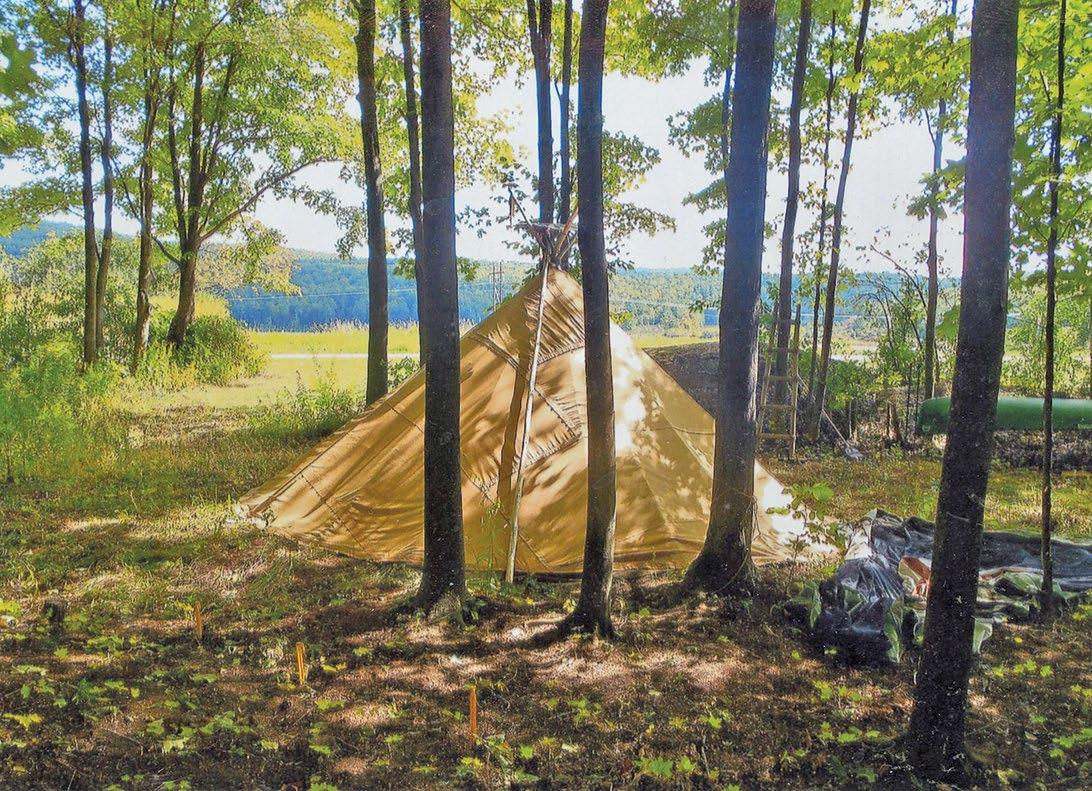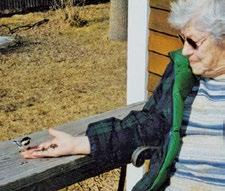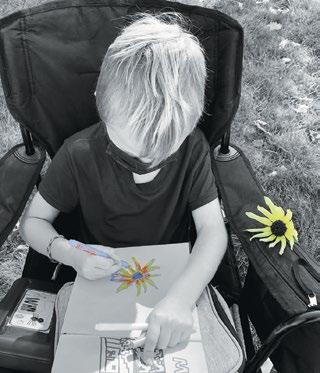
13 minute read
How the Wisdom of Mentors Guided My Steps into Nature
How the Wisdom of Mentors Guided My Steps intoNature
By Sharon Powers
Advertisement
For a young adult it may seem like society expects you to be working steadily toward your higher education or career. But what if society doesn’t offer what you want to learn? Enter: self-education and seeking mentors. I am a nature lover and fondly remember sunny days with my mom enjoying the outdoors. Our family had lots of pets — a rabbit, hamsters, birds, fish, a turtle, cats, dogs and ponies. But my mom had a thing for hand-taming wild animals. You might see her sitting out on the lawn after dark coaxing a raccoon out of its hole to eat from her hand (she did this with skunks too). Or coming home from school, she’d say, “Listen, there’s a wild cat in the spare bedroom. Don’t go in there and don’t tell Dad.” On a warm afternoon we could find the honey bee’s home by painting some bright blue chalk powder on the bee’s backside with a small watercolor paintbrush, and tracking the direction and timing of its return. So cool!
There was a day in winter when she had already tamed the chickadees (this takes months), and she stuck me out there on the snowy deck to experience it for the first time.
I still tame chickadees today. Simply start by leaving a glove with seed in the palm near the feeder. Begin to put very little food in the feeder so that it runs out more often. With lots of stillness and patience you can transition to sitting out there to feed. It only works with an empty feeder. And if you ever get those little chickadees tame, you can stick your favorite elder or kids out there and see some joy come alive!
I grew up on the west shore of Grand Isle, Vermont, so Lake Champlain was right there. Our summers were especially amazing with freedom to roam the old cedar woods and mess around in boats. The neighbors were a very traditional farm family — three boys — and I had four brothers. With all those boys around, I was happy to pal around with a girl down the road. At the neighbor’s farm — I called it “Mary’s house” — her working kitchen was just so fascinating to me that I spent a lot of time there, so much that I kind of blended in sometimes. After all, Mary did not have a daughter; maybe I fulfilled something for her, too. Their way of life was different from ours in that they worked the land producing so much food, and my dear stepdad commuted to his bank job. I tromped all over that farm, including the hedgerows and forest. I could see how tied to the land these folks were.
There was a related man — we called him “Uncle Richard” — and he would let me tag along when he gathered big baskets of butternuts up in the hedgerow. He would let me sit and watch him clean buckets of fish from ice-fishing, which he then sold in the city. But I could only hang out with him under one condition: that I didn’t talk, just keep quiet. It was a phenomenal way to learn a skill, all good. I did keep in touch with Mary all through her old age. She lived to be 91. That’s her picture holding a chickadee.
You can count yourself lucky to have a parent(s), relative
“Blend with the land and celebrate life.” —Hopi

or neighbor as good first mentors. It doesn’t always work out. My mom remarried to my dear stepdad, but my blood father was an outdoor legend, a hunting and fishing guide and part Cree descendant. He lived with the Cree in northern Quebec for two years beyond any roads, and spoke the language. I met him when I was 17, but that’s a story for another time! He was my non-mentor in a way, you know?
Is that why I went directly to nature to learn? My secret sit spot was on a bluff overlooking the lake 30 feet below. From there you could see so much sky and water, the distant shore. And, of course, it’s all moving with sparkling waves, the clouds and gulls flying by. Always the sounds of birds and waves, the feeling of the breezes — so enchanting.
It came to me there, around age 12, that I could not identify anyone who lived in balance with the natural world. Not my family, not even the farmers next door, because they basically worked to extract resources. The forest to them was firewood, fence posts and nut harvest. I decided right there, thanks to Mother Nature, that the lifeway of Native people would guide me.
In 1989 I attended a five-day residential group retreat with Sun Bear. He was a Native teacher and author of sustainability and culture books, such as The Medicine Wheel: Earth Astrology. The small gathering took place at a rural auberge near Sherbrooke, Quebec. Out of the 15 people, I was the only one besides Sun Bear who did not speak French, so he would pause in a teaching and ask me to clarify for our bilingual friends.
Every day he would have us go individually out on the land to practice our new rituals and guided meditations. And each day it was for a longer time. I began to feel frustrated because, well, I already spent lots of time outdoors alone. I signed up to be with Sun Bear; was I getting my money’s worth?
It was June and the woods were bursting with life. On the final day’s outing I had gone far enough in that I broke branchlets to mark my way back. My appeal and inquiry was to the Plant People, the Green Nation. I was 31, a few years into a happy marriage and a career teaching in the outdoors. My calling was botany, and I could identify plants and assess their habitats, yet something was missing. I longed to learn about the deeper nature of plants from an Earth-based elder and to see the plants through native eyes.
So, on that final day I set up my four directions on a great slab of rock in the forest, and did the rituals in each direction. And something happened...
It was so powerful and humbling to directly receive a message, as if by osmosis: “You call yourself a botanist. That can be so insulting, like a birdwatcher whose only goal is a check mark next to a species. Maybe you’ll come across a medicine plant with so much complexity and history with the People, and all you will know is the name. Big deal.”
Gulp, what was that, I wondered?! Then this: “Green plants are the base of the whole world’s food chain. Designed to be of a giving nature, plants offer us their food and medicine, the joy of aroma and taste, the life-giving breath of oxygen, fuel for warmth, and all the building materials for our homes. Don’t forget about all the dazzling colors of flowers! Receive their gifts!”
When I left the event, I knew that it was herbal medicine that would be the focus of my adult self-education, and soon thereafter met Rosemary Gladstar, to become one of her first Vermont apprentices in the Art and Science of Herbalism. Rosemary had twelve apprentices that year many moons ago. We met in her home one weekend per month for nine months. Talk about hands-on! We learned so much from invited Native elders, a primitive skills guy, and master gardeners who worked with us. There were field trips, large gatherings (like Green Nations Gathering), and one-week intensives.
Rosemary allowed me to walk along to her vision quest spot on Sage Mountain. There she would stay for days with no food, just a hammock and tarp. We went higher and further, seeing fresh moose and bear signs. And back I walked, leaving a defenseless woman way, way out there. Thank you, Rosemary, for being the ultimate stepping-into-nature mentor!
I had heard of a man in northern Wisconsin who took a mentor approach to outdoor education. That would be Tamarack Song, a teacher of old way skills (he calls it Clan Way or Circle Way) at the Teaching Drum Outdoor School. A number of students, or “seekers,” commit to spending most of their time for one whole year living like the old days of the traditional Ojibwe People. The school would provide the food, but otherwise it’s nature immersion.
We exchanged letters over the years. My second one-week visit with Tamarack and his wife Lety was with my teenage nephew Ivan. We set up my conical travel wigwam right near the house. They had us in for breakfast. Lety spread a cloth out on the floor and set out bowls of mixed fruit salad and a variety of nuts. “We haven’t sat at a table to eat in years,” she said. On the wood stove, little tins of oil were gently warming. Tamarack was


Bhavna’s Wellness Group

Bhavna Srivastava, the founder of BWG is a Healer and Intuitive Transformational Coach. Are you feeling overwhelmed, anxious, lost, struggling to find your soul purpose or broken heart? Mention this ad for a free 30 minute Discovery Session to see how Bhavna can help you.
Shine your Light Programs
1 year Certificate Mastermind Program valued at $80,000+ with this ad RECEIVE a 90% DISCOUNT! A Program to jumpstart you in your life’s Soul Mission. Filled with Conscious living, activations, Initiations, Soul Codes, Light language activations, Connection to your light, knowing your light, Reawakening yourself. Shift from 3D to 5D. Once a month for 2 hours with 15 min follow up bi weekly. It is a group webinar on zoom. Payment Plans available. Bonus:
1. Manifesting Soul Money
Abundance 6 sessions 2. Manifesting Soul Relationships 3. Curse Clearing 4. Ancestral Money Clearing 2 parts
5. Ancestral Relationship Clearing 6. 12 Monthly Meditations 7. 2 Personal Sessions with Bhavna to help shift your mindset/trauma 8. Closed Private FB Group Connection Enrollment Open Now - Reserve your Space
Contact Bhavna call or text at (774) 242-2112 or email Customerservice@bhwellnessgroup.com
FACEBOOK: BHWellnessGroup • TWITTER: BHWellnessGrp www.bhwellnessgroup.com

DR. ISRAEL & CATHIE HELFAND Helping thousands of couples over 35 years.
PRIVATE INTENSIVE 3-DAY
RETREAT IN VERMONT
“#1 Marriage Retreat in US”— Guide Doc

Past clients say “Better than a year of therapy!” MarriageQuest.org

Online Personal Sessions & Classes
•Energize Your Immune System
Pitch Pipe Harmonic Humming Technique •Your Body’s Musical Key
Hum Your Chakras—Relieve Anxiety & Depression SCHEDULE A SOUND SESSION
508-981-6896 • thesoundlady.com
Touchstone
COMMUNITY SCHOOL

PK-8th Grade • Multi-age Classrooms • Design Thinking • Thematic Project Studies • Math & Literacy Specialists • Sustainability • Individualized, Supported Learning Environment Accepting Applications for 2021-22!
touchstoneschool.com 508-839-0038
doing a study on the fats of different wildlife (obtained from roadkill), and later wrote a book about it.
I spent whole summers with my nephew. We travelled with both my wigwam encampment and modern gear to step out into nature. After the Wisconsin visit, it was on to the Porcupine Mountains of the Upper Penninsula of Michigan, the largest tract of old growth forest in North America, and right on Lake Superior. For our first few nights we found a hidden spot on a high bench not too far from the parking area. We set up our hammock and tarps, made a little fireplace and it was magical. The trees are so tall, and there’s not much underbrush, so you can walk around pretty well.
During our last night, just pre-dawn and not very far away, a giant tree fell down in the forest! Strange cracking sounds, a whoosh and a thud so hard you could feel it shake the ground. Whoa, it wasn’t even windy! It made us look up at the trees and branches where our camp was in a new way. Always put your camp away from the widow-maker.
Still in the Porkies, we had a new plan: get a permit for the vehicle at a trailhead, then go the other way off-trail. Ha! I could see on the map a brook drainage that led a few miles right to Lake Superior. Great adventure! The walk was gorgeous — you could not keep from craning your neck upwards to see the canopy — like a living cathedral! We made it to the shore and a lovely camp spot out of any wind. We hung the food away from bears, had a great campfire and sang the eagle calling song gifted to me by a Native elder.
At bedtime all is well, except I did notice the skeeters were swarming the minute one left the campfire. Hmmm... Ivan’s hammock was bombproof for bugs (made it myself) with netting and zipper built-in. Mine was a new design I was trying out. It had no zipper, but a big overlap on top. Guess what? I got bit every five minutes all night! They say the itch to go north is nothing like the itch of being there. I felt miserable in the AM. After good coffee and breakfast, we went out to the rocky shore. A bald eagle sitting nearby stayed. That day we bailed out, but the experience was worth it.
Jon Young is a dedicated wilderness mentor who speaks of the value of placing yourself in wild nature — some place where man is not in control. Create a secret spot, called a “sit spot,” where you can visit fairly easily. When you spend time there in different seasons and times of day, there’s a familiarity that takes hold. You know where the plants and rock are, as familiar as your own living room.
I go way back with a sit spot. With a little exploring of the wilder pockets of accessible land, you will find them! One summer day I came across a glacial boulder with an overhang so big you could stay dry on a wet day. I start bonding with the spot by being quiet and observant. For some reason I enjoy picking up the dead sticks all around; it makes it easier to move about, and it feels like woodland gardening. Into the zone, gather sticks, walk to brush pile and back. Once I looked up to find a doe standing 30 feet away watching me. I sat down and mimicked her behavior of nibbling a leaf. She proceeded to act like a tame goat, just staying close by with a wiggly drooping tail (that means content). It’s never happened since — a real Jane Goodall moment!
When wandering in the natural world, all of your senses are engaged at once, allowing pure learning to really sink in. Try it. The wildness of Earth is our home. All those communities of wetlands and bugs…the diversity of species was all humming along before humans evolved our advanced consciousness. We are the newer form — the younger sibling — in the grand scheme, and we still need to learn how we fit in.
Sharon in Sweden 2008
The wildness of Earth is our home. We are the newer form — the younger sibling — in the grand scheme, and we still need to learn how we fit in.
It has been 42 years since Sharon Powers spent her first summer living in a handmade 18th century style tipi, or wigwam. From Wyoming to Florida she has traveled the country, maintaining Native camp for seasons at a time. For 15 years she was active in historic re-enactments using her wigwam encampment, where large gatherings lasted up to 10 days. She also participated in many school programs and smaller gatherings as an outdoor educator/mentor, including the Spirit of Change Harvest Gatherings at the turn of this century. Her lodge currently sits just off the lawn in a future sugar maple grove where she can leave her comfy apartment at night to sleep outdoors. Sharon can be reached at sharonpowersanderson@gmail.com.

